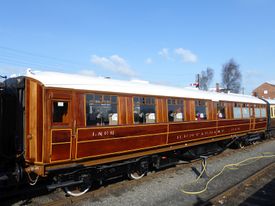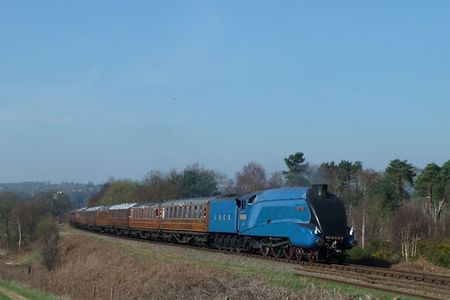LNER 7960 Kitchen Composite
| LNER 7960 Kitchen Composite | |
|---|---|
 LNER Kitchen Composite 7960 | |
| Built By | LNER Doncaster |
| Status | In service |
| Number | 7960 |
| Other numbers | 9162, SC9162E, DE321021 |
| History | |
| Built | 1936 |
| Designed By | Gresley |
| Diagram | 187 |
| Lot | 673 |
| Type | RC |
| Length | 61ft 6in |
| Weight | 42t 15cwt |
| Seats | 12 first, 18 third (as built) |
| 1980 | Preserved on SVR |
| 2015 | 1989 restoration began |
| 2012 | First use in passenger service |
| 2015 | Restoration completed |
LNER 7960 is the last surviving example of an LNER Kitchen Composite (RC).[1] Since its lengthy restoration was completed in 2015 it has mainly seen use on special dining trains.
Contents
7960 in service
7960 was designed by LNER CME Sir Nigel Gresley and built at Doncaster in 1936 to LNER Diagram 187.[2] The layout comprised an entrance vestibule giving access to a third-class saloon seating 18, followed by the first-class saloon seating 12. A side corridor leading from the first-class saloon gave access to a pantry compartment, an anthracite-electric kitchen and finally an attendant's lavatory. The interior of the third-class saloon was finished in varnished teak with polished brass metal fittings; the first-class saloon had quartered 'fiddle-back' veneered panels with mahogany trim and polished chrome metal fittings.[note 1] Power was provided by two Stones dynamos rated at 7·2kW, mounted on the underframe, and supplemented by batteries.[1]
7960's regular diagram was on the Great North of Scotland route between Aberdeen and Inverness, serving breakfast on the 7.00am northbound and dinner on 12.30pm return service.[1] It was renumbered as 9162 as part of the LNER's 1943 re-numbering scheme. On Nationalisation in 1947, BR initially allocated an E prefix to indicate its LNER origin, with a further re-numbering to SC9162E after 1951.[3]
In 1957 BR began a 5-year programme to replace all its pre-1939 catering vehicles. Although some other LNER carriages were converted to propane equipment to extend their working lives, 7960 was not so treated and was withdrawn in 1961.[1] After withdrawal from passenger service it was converted to a Mess Coach for Scottish Region track workers, as departmental number DE 321021 from December 1963.[2] The third class saloon was most altered to three sleeping compartments with a side corridor, and the former first class to a messroom complete with coal burning stove. Surprisingly the kitchen remained largely untouched, although at some stage in its life the anthracite-electric cooker was replaced with gas.
7960 in preservation
7960 arrived on the SVR by rail from Perth in late 1980,[4] having been purchased privately by John Giles.[5] It was painted black and was in run down condition. It spent most of the decade in Kidderminster yard where it remained largely untouched,[6] apart from the bogies which were overhauled and temporarily fitted under Buffet Car 643.[4]
Around 1989 Phil James assumed ownership of 7960, having 'taken pity on its woeful condition'.[1][note 2] A small team, mainly comprising Phil and his colleague Graham Gardner, spent the next 20 years painstakingly restoring it to original condition, initially at Kidderminster and later at Bewdley. During the first winter it was moved into Kidderminster Carriage Works to be made watertight.[7] By 1999 all of the large teak panels were fitted and varnished, and all of the quarterlight units overhauled, reglazed and refitted.[8] Work continued at Bewdley; in winter 2007 it returned to Kidderminster for contract finishing of the vacuum and steam heat and to be returned onto its own overhauled bogies.[9]
By 2008 the project was nearing completion apart from the kitchen fittings, although Phil had been suffering from a lengthy illness which was beginning to affect his ability to work.[1] Phil sadly passed away in March 2009. A team of volunteers continued with the restoration and in autumn 2010 it featured as a static exhibit during the Autumn Steam Gala. 7960 was generously gifted by his widow Louise to the SVR Rolling Stock Trust (now The SVR Charitable Trust in January 2011.
The 2012 Spring Steam Gala had an 'LNER' theme, during which 7960 made its first run in public service, carrying its first passengers on Friday 21 May 2012.[10]
Final completion of the kitchen and pantry took place in 2015 allowing 7960 to enter catering service. Phil James and Paul Bennett created a very interesting website, hosted by the Great Western (SVR) association which documented much of the restoration and which may be found at 7960 pages
On 5 April 2016 a contentious bronze sculpture by Hazel Reeves of Sir Nigel Gresley was unveiled during a ceremony at King’s Cross station in London.[11] 7960 was one of the stars of the show, on display on Platform 8.[12]
In 2019 7960 was used in "The Gin Train" and other similar events, where it was billed as "our 1936-built luxurious first class carriage (once hauled by the Flying Scotsman)"[13]
In 2022 gangway repairs followed a shunting accident. Also, a gas engineer has isolated two burners on the oven and installed heat-resistant extraction fans, which now allow 7960 to offer hot-work cooking when chartered[14].
See also
Notes
- ↑ The interiors were in a traditional style with darker veneers rather than the 'art deco' style of the Opens.
- ↑ Phil James spent many years involved in the preservation of GWR coaches at Bewdley, and at different times served as the secretary of the SVRA and the Great Western (SVR) Association.
References
- ↑ 1.0 1.1 1.2 1.3 1.4 1.5 lnersvrcoachfund.org.uk
- ↑ 2.0 2.1 Longworth (2018) p.266.
- ↑ Longworth (2018) p.175.
- ↑ 4.0 4.1 SVR Stock Book Ninth Edition
- ↑ SVR News 64
- ↑ GW(SVRA) 7960 Restoration Part 1
- ↑ SVR News 94
- ↑ SVR News 129
- ↑ SVR News 160, 161
- ↑ SVR News 178, 179
- ↑ Pantry, L., 'Nigel Gresley statue unveiled at King’s Cross - and he’s out for a duck', Yorkshire Post, 5 April 2016 (Retrieved 18 March 2018)
- ↑ 'Starring Role for Kitchen Composite 7960', SVRLive webpage 23 April 2016
- ↑ Special Events on www.svr.co.uk
- ↑ Branch Lines, December 2022
Links
| ||||||||||||||||||||||||||||||

